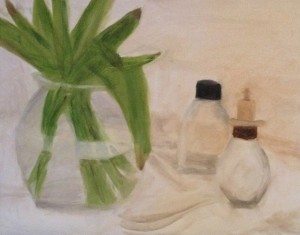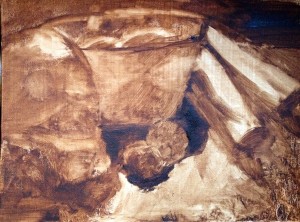
A Beginner’s Take on Oil Painting
Over the past decade, I’ve shot over 100,000 frames. Easily.
My average is probably about 15,000 a year. (And with recent endeavours into timelapse photography, it’s only going up.)
All this to say, in retrospect, it’s surprising that it’s taken so long for me to pick up a paintbrush in a meaningful way. I’ve raided a Dollar Store shelf before, and probably made a solid mess in kindergarten. But this round put me under the tutelage of Jessica Houston, an art teacher with 20 years under her belt. It also introduced me The Griffintown Art School, a winding maze of art studios, half-finished canvases, art supplies in disarray, a combination of original art and Titian/Kandinsky prints (in great elaborate frames) covering the walls, all chaotically hosted in what once was certainly a magnificent 100+ year old building.
A creative paradise.
The short albeit sweet program was very rewarding. Not because of the “art” we produced. Calling what we produced art (as a group of first time painters) is a bit longer than a long shot.
From Light to Dark
The first thing I picked up concerned the balance between lights, mid-tones and darks. A painting is built. It was hard at the outset to not try to focus on the outline.
Our first exercise focussed on still-life. In building the painting, we’d close one eye, squint the other and study the relationship between darkness levels. We’d then start putting in the layers, designating areas as lights, mid-tones and darks. This painting I made (which I call “An Unfinished Resemblance of A Bowl, With Round Shapes, Leek Shapes and A Beat Up Skull, No. 1” ), was made with only brown, no white, and a large amount of wiping. The wiping cleared some of the browns to create highlights, while filling in others with more or less paint created the range in lights and darks.
(Note: It was my first painting. And was very rushed. Constructive criticism is not welcome.)
Creating Colours
It is only the very beginning, but colours needed to be explored. Taking candid/street/whatever -it-can-be-called photography demands observation of colours and capturing, recording what is seen. Once you need to (re)create a colour, the exploration becomes that much deeper and concerted. Relationships, complements, and contrasts all have different effects on the colours used.

Still Life of A Jar That Was Different During The Second Class Resulting in An Overgrown Leaf (and Small Bottles I Like)
Painting has given me an appreciation for whites. There is rarely a pure white (made by “mixing red, blue and green light at full intensity”), in nature, aside from a cup of milk and undisturbed snow. Even where it does occur, it readily absorbs colour. Balancing whites, was and is a delicate process.
Seeing the World in Lines and Dots
Perspective is interesting to play with. The biggest challenge, and a fundamental difference between painting and photography is interpretation (of plane especially). Making a 2D interpretation of a 3D world requires seeing things in 2D, or flat. So a line doesn’t move backwards and forwards, but up and down at an angle, and shrinking towards the background. Ellipses are especially challenging – going from a circle/oval shape when viewed from above to being a line when seen at 180 degrees.
Probably something to do with our round eyeballs.
Painting, even as a most basic introduction can impart an appreciation for the shapes, colours and textures in the space around us. Photography is a great way of developing awareness for composition, texture, light on a basic level, recording colours and more. Painting takes all of this to a new level, begging the painter to see the world in layers and understanding what light and colour are made of.
And that’s the most important idea I’ll take from painting. Perhaps being the close cousins they are, photography and painting fundamentally would feed off each other. Finding inspiration and connecting the dots in unexpected and new ways, is exhilarating. The exploration of where 2 fields intersect and overlap, be they closely related or strangers, makes creative exploration incredibly rewarding – and has wide ranging benefits across a range of different fields.
And for the bucket list – I actually sold a (the third!) painting I made. It’s of Antoine Le Chien, with a toy in his mouth.
Ok, for $2. And I haven’t collected it yet.
But it still counts.
Posted in: 4 weeks project · Art · inspiration

